|
Everybody in the soaring world knows the name, Richard H. (Dick) Johnson.
However, many visitors to this web site may not know the name nor his reputation, achievements or
qualifications for performing flight test evaluations. The following is presented to introduce
Dick Johnson to you:
Beginnings
Dick is a lifelong pilot who first trained and soloed in a Northrup primary glider during 1938 at age 15.
He's not sure that his mother knew what he was doing! Dick received a private glider license in 1940,
and a commercial glider license in 1941.
He was a civilian flight instructor for the Army Air Corps Basic Glider Training
School at 29 Palms, CA for 14 months at the beginning of WWII. Two 6-hour shifts were flown each day,
and two additional 6-hour shifts were flown each night, 7 days per week.
Dick received a commercial airplane pilot license during 1942, and was a copilot with
Pan American Pacific Division for 5 years.
Education
Dick returned to engineering schooling in 1947, and received a BS in Aero Engineering from Mississippi
State University in 1952, and an MS in Aero Engineering from Stanford University in 1953.
Professional Career
Dick has worked as an aerodynamicist in the aircraft and missile industry for 42 years,
and is still employed by Raytheon on a part time basis. While working at Texas Instruments,
Dick was instrumental in developing laser guidance systems for missles and bombs.
This is reported in
TI demonstrates laser guidance system for bombs
as follows:
"Dick Johnson, regarded as one of the country’s premier aeronautical engineers,
returned from an international soaring competition in Yugoslavia and began retooling
the proposal Word and Penisten had developed. While evaluating various ideas on an analog computer,
he began defining ways for TI to place a guidance system on a missile with fins. Johnson,
along with engineer Ron Hirsch, devised a unique floating head, a so-called “birdie head,”
to house the seeker. Their approach enabled the bomb to stay fixed on the laser-designated
spot without the use of stabilization gyros or input from the launch craft.
The birdie head directed the bomb precisely toward its target."
"The seeker was simple. It was low cost. And it gave TI the potential of providing the Air Force
with test hardware in a mere 60 days after receiving the $99,000 study contract."
"Because of the tight, 60-day deadline, however, Johnson did not have time to conduct full up-wind
tunnel modeling, so he improvised, using his own lathe to machine a one-sixteenth-inch scale model
of the precision-guided bombs. He then dropped them in a swimming pool to establish critical
centers of pressure."
Soaring
Dick has competed in many National Gliding Contests since 1940.
He won the US Nationals 11 times; first in 1950 and last in 1985. He also set a world
gliding distance record in 1951 with a flight from Odessa, TX to Salina, KA (535 miles),
a record that held for 12 years.
Glider Performance
Dick learned glider performance testing techniques under Dr. August Raspet while attending
Mississippi State University. He has published more than 100 sailplane flight-testing related
articles, mostly in Soaring Magazine, concerning flight performance measurements and handling
qualities of modern sailplanes. Dick's performance data are cited in books on sailplane design; e.g.,
Sailplanes 1965-2000 by Martin Simons.
Footnote
On July 23, 2008 Dick Johnson, age 85, passed from this life while flying his Ventus glider at Midlothain, Texas.
He launched at noon to check soaring conditions before launch operations were to begin for a contest
at the Texas Soaring Association field. Shortly after releasing from the tow plane, radio communications with
Dick ceased and his glider was seen descending into trees a few miles southeast of the field. Dick was
found deceased upon arrival of the search team. It was a sad day for the Soaring world and all who knew Dick.
He had a profound influence for good on the lives of many people.
Soaring Society of America Memorial Page
|
For more on Dick Johnson, go to Wikipedia.
Jim Hendrix
|
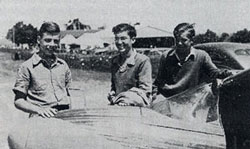
Read about Johnson's Silver C Flight at the
1940 National Contest
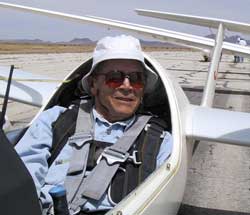
Dick Johnson
Marfa, Texas
April, 2002
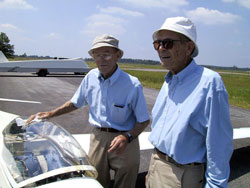
Tom Hardy—Dick Johnson
May 23, 2003
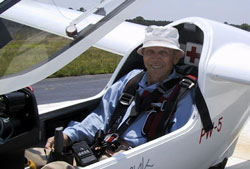
Dick Johnson, Starkville, Mississippi
May 23, 2003
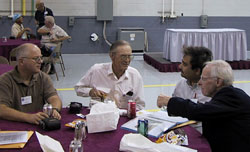
Hendrix—Johnson—Sinha—McCready
13th National Soaring Landmark Dedication
Raspet Flight Research Laboratory
November 11, 2003
|